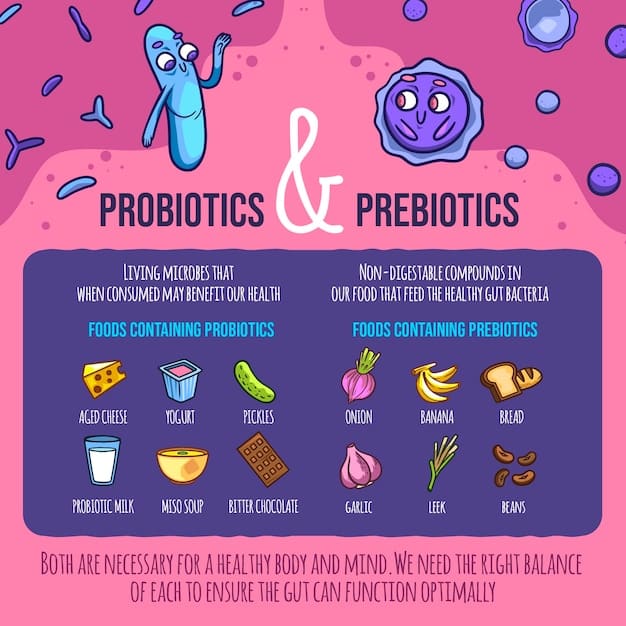How to Choose the Right Probiotic: 2025 US Guide

Navigating the vast array of probiotic supplements available in the US market requires understanding key factors like strain specificity, CFU count, and third-party verification to effectively support your gut health goals in 2025.
In the evolving landscape of health and wellness, optimizing gut health has emerged as a cornerstone of overall well-being. Knowing how to choose the right probiotic: a 2025 guide for gut health in the US, can transform your approach to digestive and immune support. This comprehensive guide aims to demystify probiotics, offering practical, evidence-based insights to help you make informed decisions tailored to your individual needs.
Understanding Probiotics and Their Role in Gut Health
The intricate ecosystem within our gut, often referred to as the microbiome, plays a pivotal role in our health, influencing everything from digestion and nutrient absorption to immune function and even mood. Within this complex environment, live microorganisms, primarily bacteria and yeasts, coexist. Probiotics, by definition, are live microorganisms that, when administered in adequate amounts, confer a health benefit on the host. This concept underscores their importance in maintaining a balanced and thriving gut.
Maintaining a balanced microbiome is not merely a trend; it’s a fundamental aspect of preventive health. When the balance is disrupted, a state known as dysbiosis, it can lead to various health issues, including digestive discomfort, impaired immunity, and even systemic inflammation. Factors such as diet, stress, medication (especially antibiotics), and environmental toxins can all contribute to this imbalance. Probiotics are believed to help restore equilibrium by introducing beneficial microbes, potentially out-competing harmful ones and supporting the integrity of the gut lining.
The scientific understanding of probiotics is continually advancing, with new research emerging regularly. While the general public increasingly recognizes their benefits, the specifics of how different strains interact with the human body are complex and varied. The “one-size-fits-all” approach rarely applies when it comes to probiotics, necessitating a personalized strategy for selection.
The diverse world of probiotics extends beyond just a single type of beneficial microorganism. There are numerous strains, each with unique characteristics and potential benefits. For example, some strains may primarily support digestive regularity, while others might focus on enhancing immune responses or even influencing mental well-being. This diversity highlights why a deeper understanding of specific strains is crucial for targeted health improvements.
Types of Probiotic Strains and Their General Benefits
When exploring probiotics, you’ll encounter various genera, species, and strains. The most common genera include Lactobacillus and Bifidobacterium, though others like Saccharomyces boulardii (a beneficial yeast) are also significant. Each offers distinct advantages. Recognizing these differences is the first step toward making an informed choice.
- Lactobacillus Strains: Commonly found in fermented foods, these strains are often associated with supporting digestion, particularly lactose intolerance, and may aid in managing certain types of diarrhea.
- Bifidobacterium Strains: Predominantly found in the large intestine, these strains are frequently linked to immune system support and may help relieve symptoms of irritable bowel syndrome (IBS) and constipation.
- Saccharomyces boulardii: This unique probiotic yeast is known for its effectiveness in preventing and treating antibiotic-associated diarrhea and traveler’s diarrhea. It’s often robust and can survive harsh stomach acid.
The field of probiotic research continues to uncover new applications, moving beyond just gut health. Emerging studies are exploring their roles in skin health, weight management, and even in mitigating symptoms of certain chronic conditions. However, it’s essential to differentiate between anecdotal evidence and scientifically validated claims when considering these broader applications. The focus remains on how these microscopic allies can contribute meaningfully to internal balance.
In summary, understanding what probiotics are and their fundamental role in maintaining a healthy gut microbiome is the foundational step. The diversity of available strains means that an effective probiotic regimen is highly individualized, requiring careful consideration of one’s specific health goals and existing conditions. This initial insight sets the stage for a more detailed exploration of how to navigate the complex probiotic market effectively.
Key Factors to Consider When Choosing a Probiotic
Selecting the right probiotic is far from a simple task, given the multitude of options flooding the market in 2025. This decision requires a nuanced understanding of several critical factors that differentiate effective supplements from those that offer minimal benefit. Ignoring these considerations can lead to suboptimal outcomes, or even wasted investment. The journey to a healthier gut begins with informed choices based on scientific principles.
The specific health concern you aim to address should be the primary driver of your probiotic selection. Are you battling chronic digestive issues, recovering from a course of antibiotics, or seeking general immune support? Different probiotic strains are supported by scientific research for specific conditions. For instance, a probiotic beneficial for IBS might not be the best choice for someone aiming to reduce instances of common colds. This targeted approach is essential for achieving desired results; generic products often lack the specificity needed for significant impact.
Furthermore, understanding the product label extends beyond just identifying the strains. It involves deciphering the colony-forming units (CFUs), ensuring proper storage, and verifying the presence of helpful prebiotics. Prebiotics are non-digestible food ingredients that act as fuel for beneficial gut bacteria, essentially helping the probiotics you consume thrive and multiply within your system. This symbiotic relationship often enhances the probiotic’s effectiveness.
Strain Specificity and CFU Count: What Matters Most?
Two of the most crucial elements on any probiotic label are the specific strains listed and their total colony-forming units (CFUs). Ignoring these details is akin to buying medication without knowing its active ingredient or dosage.
- Strain Specificity: Look for probiotics that list the specific strain (e.g., *Lactobacillus acidophilus* NCFM or *Bifidobacterium lactis* HN019), not just the genus. Research often validates benefits for specific strains, not entire species.
- CFU Count: This indicates the number of live microorganisms per dose. While higher counts (billions) are often touted, the optimal CFU count depends on the specific strain and the intended health benefit. Some strains are effective at lower CFUs, while others require significantly more. It’s not always about quantity, but effectiveness at the indicated dose.
Beyond the microbes themselves, the delivery system plays a vital role. Probiotics are living organisms, and their viability can be compromised by stomach acid, bile, and even storage conditions. Therefore, features like enteric coating or delayed-release capsules can significantly impact how many live bacteria reach your intestines, where they can exert their beneficial effects. A high CFU count at the time of manufacturing means little if those bacteria don’t survive their journey through the digestive tract.
Another critical consideration is the presence of allergens and unnecessary fillers. Many people seeking probiotics are already sensitive to certain ingredients, making it important to scrutinize the “other ingredients” list. Avoiding common allergens like dairy, soy, or gluten can prevent adverse reactions and ensure the supplement aligns with dietary restrictions. Clean formulations are often a sign of a reputable manufacturer.
Quality Assurance and Third-Party Testing: Ensuring Efficacy and Safety
The probiotic market is not as strictly regulated as prescription medications, making third-party testing and quality assurance paramount. This is where the importance of transparency and independent verification comes into play.
- Third-Party Testing: Look for products that have been independently tested by third-party organizations. This verifies the product contains the stated strains and CFUs, and is free from contaminants.
- Good Manufacturing Practices (GMP): Ensure the manufacturer adheres to GMP standards, indicating a commitment to quality control throughout the production process. This minimizes the risk of contamination and ensures product consistency.
- Stability Testing: Reputable brands conduct stability testing to ensure the probiotics remain viable and potent throughout their shelf life, assuming proper storage.
In essence, choosing a probiotic is a blend of scientific understanding and diligent label reading. By prioritizing strain specificity, appropriate CFU count, a suitable delivery system, and verification of quality assurance, consumers can dramatically improve their chances of selecting a probiotic that genuinely supports their health goals in 2025. This careful approach moves beyond mere marketing claims and grounds the decision in evidence and thoughtful consideration.

Common Health Conditions and Targeted Probiotic Strains
The targeted application of probiotics is where their true power lies. While general gut health support is valuable, specific health conditions often benefit more from particular strains that have been studied and shown to be effective for those indications. Understanding this distinction is crucial for personalized and effective supplementation. In 2025, the research linking specific strains to specific outcomes is more robust than ever, empowering consumers to make highly informed choices.
For instance, managing digestive discomforts like bloating, gas, and irregular bowel movements can be significantly improved with the right probiotic. Many individuals experience these issues as part of irritable bowel syndrome (IBS) or simply due to dietary sensitivities. Certain Bifidobacterium and Lactobacillus strains have demonstrated efficacy in alleviating these symptoms by modulating gut motility, reducing inflammation, and improving the gut barrier function.
Beyond digestive health, the ripple effects of a healthy microbiome extend to the immune system. A significant portion of our immune cells reside in the gut, making the gut-associated lymphoid tissue (GALT) a critical component of our body’s defense. Probiotics can influence immune responses by interacting with immune cells, producing beneficial compounds, and maintaining the integrity of the gut lining, which acts as a barrier against pathogens.
Probiotics for Digestive Issues: IBS, Constipation, and Diarrhea
Digestive complaints are among the most common reasons individuals seek probiotic support. Tailoring the strain to the specific issue can make a significant difference.
- Irritable Bowel Syndrome (IBS): Look for strains such as *Bifidobacterium infantis* 35624, *Lactobacillus plantarum* 299v, or combinations proven in clinical trials to reduce IBS symptoms like abdominal pain, bloating, and gas.
- Constipation: *Bifidobacterium lactis* HN019 and *Lactobacillus reuteri* DSM 17938 are often cited for their ability to improve bowel regularity and stool consistency.
- Diarrhea (Antibiotic-Associated & Traveler’s Diarrhea): *Saccharomyces boulardii* is highly recommended for preventing and treating these types of diarrhea, as it is a yeast and not affected by antibiotics. Certain *Lactobacillus rhamnosus* strains (e.g., GG) also show strong evidence.
The connection between gut health and mental well-being, often referred to as the “gut-brain axis,” is another burgeoning area of probiotic research. The gut produces neurotransmitters like serotonin, and an imbalanced microbiome can contribute to mood disturbances. Certain psychobiotics, or probiotics with mental health benefits, are beginning to gain recognition for their potential role in supporting mood and stress response.
This complex interplay means that addressing gut health can have wide-ranging positive effects beyond the digestive tract. However, it also underscores the need for careful selection, as not all probiotics will offer the same benefits across different conditions. The emerging science guides us towards more precise recommendations.
Immune System Support and Beyond: Exploring Broader Benefits
The influence of probiotics extends far beyond digestion, significantly impacting the body’s defensive capabilities and other systemic functions.
- Immune Function: Strains like *Lactobacillus rhamnosus* GG (LGG), *Bifidobacterium lactis* Bl-04, and HN019 have been studied for their ability to enhance immune responses, potentially reducing the incidence and duration of common respiratory infections.
- Vaginal Health: Specific *Lactobacillus* strains, particularly *L. reuteri* and *L. rhamnosus*, are important for maintaining a healthy vaginal microbiome and preventing common infections.
- Skin Health: While research is still emerging, some studies suggest that certain probiotics might influence skin conditions like eczema by modulating the immune system and reducing inflammation.
In conclusion, the efficacy of a probiotic often depends on matching the right strain to the right condition. This requires a proactive approach to understanding your specific health needs and aligning them with scientifically validated probiotic strains. Consulting with a healthcare professional can further guide this process, ensuring that the chosen probiotic regimen is safe, appropriate, and maximally effective for your unique health profile in 2025.
Dosage, Timing, and Administration: Maximizing Probiotic Efficacy
Once you’ve navigated the complexities of choosing the right probiotic, the next critical step is ensuring its optimal efficacy through proper dosage, timing, and administration. Even the most perfectly selected probiotic can fall short of its potential if not taken correctly. These often-overlooked factors play a significant role in how many live bacteria reach your gut and how well they can colonize and exert their beneficial effects. The goal is to maximize the survival and activity of these delicate microorganisms.
The dosage of probiotics, typically measured in CFUs (colony-forming units), can vary widely between products and for different health goals. There isn’t a universal “right” dose; it depends on the specific probiotic strain, the formulation, and the condition being addressed. Some strains are effective in the tens of millions, while others require billions or even hundreds of billions of CFUs to provide a therapeutic benefit. Always adhere to the manufacturer’s recommendations or a healthcare professional’s advice. Exceeding the recommended dose doesn’t necessarily lead to better results and may sometimes lead to mild digestive upset. Conversely, taking too little may not yield any significant effect.
Timing of probiotic intake is another area of discussion. Some sources suggest taking probiotics on an empty stomach to minimize exposure to stomach acid, while others recommend taking them with food to help buffer the acid. The truth is, it depends on the specific strain and the product’s formulation. Enteric-coated capsules, for instance, are designed to protect the probiotics from stomach acid regardless of food intake. However, for most standard formulations, taking them roughly 30 minutes before a meal or with a small, bland meal can often be beneficial. This allows the probiotics to pass through the stomach more quickly when acid levels might be lower.
Optimal Dosages for Different Health Goals
Understanding that one size does not fit all is paramount when it comes to probiotic dosages.
- General Digestive Health: For daily maintenance, dosages typically range from 1 billion to 10 billion CFUs daily, often with a mix of *Lactobacillus* and *Bifidobacterium* strains.
- Targeted Conditions (e.g., IBS, Diarrhea): Therapeutic doses for specific conditions can be significantly higher, sometimes ranging from 20 billion to 100 billion CFUs, often focusing on clinically studied strains for that particular ailment. Always refer to clinical research and product-specific recommendations.
Storage conditions are equally vital for maintaining the viability of live probiotic cultures. Many probiotics require refrigeration to remain potent, although shelf-stable varieties are becoming increasingly common due to advancements in freeze-drying technology and protective packaging. Always check the product label for specific storage instructions. Exposure to heat, humidity, and direct sunlight can rapidly degrade the live cultures, rendering the supplement ineffective before its expiration date. Proper storage ensures that the CFU count on the label is still accurate when you consume the product.
Integrating probiotics into your daily routine should be consistent. While some mild and temporary side effects like gas or bloating can occur when first starting a probiotic, these usually subside as your body adjusts. Starting with a lower dose and gradually increasing it can help minimize these initial discomforts. Consistency is key, as the benefits of probiotics are often cumulative and require ongoing replenishment of beneficial bacteria.
Best Practices for Administration and Storage
Proper administration and storage are vital to ensure the live cultures remain viable and effective.
- With or Without Food: Many probiotics benefit from being taken 30 minutes before a meal or with a small amount of food. However, specific product instructions should always be followed, especially for enteric-coated formulations.
- Consistency is Key: For sustained benefits, take your probiotic consistently, ideally at the same time each day, to maintain a steady influx of beneficial bacteria.
- Storage: Always check the product label. Some probiotics require refrigeration, while others are shelf-stable. Protect them from heat, humidity, and direct sunlight to preserve potency.
In conclusion, dosage, timing, and storage are not mere footnotes in the probiotic selection process; they are integral to maximizing the supplement’s effectiveness. By paying close attention to these details, consumers can significantly enhance the therapeutic potential of their chosen probiotic, contributing more effectively to their overall gut health journey in 2025.
Diet, Lifestyle, and Probiotics: A Holistic Approach
While probiotic supplements offer a targeted way to introduce beneficial microorganisms, their effectiveness is profoundly amplified when integrated into a broader lifestyle that supports gut health. A holistic approach, encompassing diet, hydration, stress management, and physical activity, creates an optimal environment for these beneficial bacteria to thrive and exert their full potential. Relying solely on a supplement without addressing foundational aspects of health is akin to patching a leak while the tap is still running at full blast.
Diet plays arguably the most significant role in shaping the gut microbiome. The foods we consume directly feed the bacteria living within us. A diet rich in diverse plant fibers—found in fruits, vegetables, whole grains, nuts, and seeds—provides essential prebiotics, the non-digestible compounds that serve as food for beneficial gut bacteria. Conversely, a diet high in processed foods, refined sugars, and unhealthy fats can promote the growth of less desirable bacteria, leading to dysbiosis and inflammation, undermining the very purpose of probiotic supplementation.
Chronic stress is another major disruptor of gut health. The gut-brain axis ensures that psychological stress can manifest as physical symptoms in the digestive system, including changes in gut motility and increased gut permeability. Stress can also alter the composition of the microbiome. While probiotics might help mitigate some of these effects, stress reduction techniques such as mindfulness, meditation, yoga, or spending time in nature are crucial for systemic well-being and a balanced gut environment. Addressing the root causes of imbalance is always more effective than merely treating symptoms.
Nourishing Your Gut: The Role of Prebiotic-Rich Foods
Prebiotics are the unsung heroes of gut health, providing essential nourishment for probiotics and your existing beneficial gut bacteria.
- Dietary Sources: Include foods like garlic, onions, leeks, asparagus, bananas, apples, oats, and legumes in your daily diet. These provide diverse types of fiber that feed different bacterial strains.
- Fermented Foods: While not technically prebiotics, fermented foods like yogurt, kefir, sauerkraut, kimchi, and kombucha naturally contain beneficial bacteria and can contribute to gut diversity. They are an excellent complement to probiotic supplements.
- Hydration: Adequate water intake is essential for digestive regularity and overall gut function, helping fiber move seamlessly through the digestive tract.
Regular physical activity also contributes positively to gut health. Exercise can enhance gut motility, reduce inflammation, and even increase the diversity of beneficial bacteria in the gut. Even moderate activity, such as a brisk walk daily, can make a difference. The benefits extend beyond digestive health, encompassing improved mood, better sleep, and reduced chronic disease risk, all of which indirectly support a healthy microbiome. This holistic approach recognizes that the body’s systems are interconnected.
Sleep quality is another often-overlooked factor. Disrupted sleep patterns can negatively impact the gut microbiome and immune function, creating a cycle where poor sleep affects gut health and a compromised gut affects sleep. Prioritizing consistent, restorative sleep hours is therefore an integral part of maintaining a healthy gut and maximizing the effectiveness of any probiotic regimen. Lifestyle adjustments are powerful tools in their own right, and when combined with targeted supplementation, they create a synergistic effect.
Lifestyle Adjustments for a Thriving Microbiome
Beyond diet, several lifestyle factors profoundly influence the health and diversity of your gut microbiome.
- Stress Management: Implement stress-reduction techniques like meditation, deep breathing exercises, or spending time in nature. Chronic stress can negatively alter gut flora.
- Regular Exercise: Consistent physical activity has been shown to increase gut microbial diversity and improve digestive transit time.
- Adequate Sleep: Prioritize 7-9 hours of quality sleep per night. Sleep deprivation can negatively impact the gut microbiome and overall immunity.
- Limit Antibiotics (When Possible): While sometimes necessary, overuse of antibiotics can decimate beneficial gut bacteria. Always discuss alternatives with your doctor.
In summary, taking a probiotic supplement is only one piece of the puzzle for optimal gut health. For enduring benefits, it must be supported by a nutrient-dense diet rich in prebiotics, effective stress management, regular physical activity, and adequate sleep. This comprehensive approach not only helps established probiotic strains flourish but also fosters a naturally resilient and diverse microbiome, setting the foundation for overall well-being in 2025 and beyond.
Potential Side Effects and When to Consult a Professional
While probiotics are generally considered safe for most healthy individuals, it’s important to be aware of potential side effects, especially when starting a new supplement regimen. Understanding when these effects are normal and when they warrant professional medical advice is crucial for a safe and effective experience. The body’s initial adjustment to new microbial populations can sometimes manifest in ways that, while usually mild and temporary, might cause concern if not anticipated.
The most common side effects associated with probiotic supplementation involve mild digestive disturbances. These can include increased gas, bloating, or changes in bowel habits, either temporary constipation or loose stools. These symptoms typically arise as the new bacteria establish themselves in the gut and displace existing populations. For most individuals, these side effects are short-lived, resolving within a few days to a couple of weeks as the microbiome adjusts and rebalances. Starting with a lower dose and gradually increasing it can often help mitigate these initial discomforts.
However, certain groups of individuals need to exercise particular caution or avoid probiotics altogether without strict medical supervision. This includes people with compromised immune systems (e.g., those undergoing chemotherapy, HIV/AIDS patients), individuals with serious underlying health conditions like pancreatitis or short bowel syndrome, and those with central venous catheters. In these cases, there’s a theoretical risk, albeit rare, of probiotics causing infections or other serious complications, as the bacteria could potentially enter the bloodstream. The decision to use probiotics in these situations must always be made in consultation with a physician who understands the patient’s full medical history.
Common, Mild Side Effects and How to Manage Them
Understanding what to expect can help ease concerns when beginning a probiotic regimen.
- Gas and Bloating: These are very common as your gut microbiome adjusts. Try starting with a lower dose or taking your probiotic with a meal to reduce these symptoms.
- Changes in Bowel Habits: You might experience temporary constipation or loose stools. This usually normalizes within a week. Ensure adequate hydration.
If side effects persist beyond a few weeks, worsen, or are severe (e.g., intense pain, bloody stools, persistent fever), it’s a clear signal to stop taking the probiotic and seek immediate medical attention. While incredibly rare, some individuals may experience allergic reactions to ingredients in the probiotic supplement, such as dairy or soy, if not explicitly free of these allergens. Symptoms of an allergic reaction might include hives, difficulty breathing, or swelling, necessitating emergency care. Always check the allergen information on the product label, especially if you have known sensitivities.
Interaction with medications is another important consideration. For instance, individuals on immunosuppressant drugs should be particularly cautious. Furthermore, if you are taking antibiotics, it is generally recommended to take your probiotic at least two to three hours apart from the antibiotic dose to maximize the survival of the beneficial bacteria. While probiotics can help mitigate antibiotic side effects, coordinating their intake with your physician or pharmacist is advisable. Open communication with your healthcare provider is paramount to avoid potential complications or reduce the efficacy of medications.
When to Seek Professional Medical Advice
Knowing when to consult a healthcare professional is crucial for safe probiotic use.
- Compromised Immune System: If you have a weakened immune system, are undergoing chemotherapy, or have a severe chronic illness, consult your doctor before taking any probiotic.
- Persistent or Worsening Symptoms: If digestive side effects persist for more than a few weeks, worsen, or become severe, stop the supplement and seek medical advice.
- Allergic Reactions: Any signs of an allergic reaction (rash, swelling, difficulty breathing) require immediate medical attention.
- Pre-existing Conditions: Individuals with conditions like short bowel syndrome or a history of heart valve disease should consult their doctor before starting probiotics due to potential risks.
- Medication Interactions: If you are on any medications, particularly immunosuppressants, discuss probiotic use with your doctor or pharmacist to avoid potential interactions.
In conclusion, while probiotics can be a powerful tool for enhancing gut health, they are not without potential considerations. Awareness of common side effects, coupled with knowledge of when to consult a professional, empowers consumers to use these supplements safely and effectively. In 2025, with an increasingly diverse range of products available, personalized guidance from healthcare providers remains an invaluable resource for navigating the complex world of probiotics.

Innovations and Future Trends in Probiotics for 2025
The world of probiotics is anything but static; it is a field brimming with ongoing research and technological advancements. As we look towards 2025, several exciting innovations are shaping the future of gut health, moving beyond traditional probiotic supplements into more sophisticated and personalized approaches. These trends promise to offer even more tailored and effective solutions for maintaining and restoring a balanced microbiome, driven by a deeper understanding of microbial interactions and individual host responses.
One of the most significant trends is the shift towards precision probiotics. Instead of broad-spectrum formulations, the focus is increasingly on identifying specific bacterial strains or consortia of strains that have highly targeted effects on particular health conditions. This is being propelled by advancements in metagenomics and bioinformatics, allowing researchers to analyze the gut microbiome with unprecedented detail. The goal is to move from general gut support to “medical foods” or prescription-grade probiotics designed for specific therapeutic outcomes, supported by rigorous clinical trials.
Personalized nutrition, already a burgeoning field, is set to integrate even more deeply with probiotic recommendations. Tools like at-home gut microbiome testing kits are becoming more accessible and sophisticated, allowing individuals to get a snapshot of their unique microbial composition. While not yet comprehensive enough for definitive diagnoses, these tests, coupled with AI-driven analysis, could eventually inform highly personalized probiotic and dietary recommendations, moving beyond the guesswork of trial and error. The future envisions bespoke probiotic solutions for each individual’s distinct gut ecosystem.
The Rise of Postbiotics and Psychobiotics
The conversation around gut health is expanding beyond live bacteria to include their beneficial byproducts and their influence on the brain.
- Postbiotics: These are the bioactive compounds produced by probiotics during fermentation or after their death. They include short-chain fatty acids, enzymes, and peptides that exert health benefits without being live organisms themselves. Postbiotics are stable, have a longer shelf life, and can offer a safer alternative for immunocompromised individuals. Look for products incorporating postbiotic components.
- Psychobiotics: This specialized class of probiotics focuses on influencing the gut-brain axis, specifically targeting mental health and cognitive function. Research is exploring strains that can produce neurotransmitters like GABA or serotonin, potentially alleviating symptoms of anxiety, depression, and stress.
The delivery mechanisms for probiotics are also undergoing significant innovation. Beyond traditional capsules and powders, we’re seeing the development of more stable and palatable forms, such as fortified functional foods, specialized chewable tablets, and even novel encapsulation technologies that protect fragile strains from environmental stress and stomach acid. This ensures better survival and colonization, increasing the efficacy of the chosen product. Improved packaging and storage solutions are also critical in maintaining product stability from manufacturing to consumption.
Furthermore, the regulatory landscape for probiotics in the US is likely to evolve to keep pace with scientific advancements. Historically, probiotics have been regulated as dietary supplements, but as more specific health claims are validated through clinical research, there may be a push for more stringent classification, potentially leading to prescription-only probiotic therapies for specific medical conditions. This would bring a new level of consumer confidence and medical oversight to highly specialized products.
Leveraging AI and Microbiome Mapping for Personalized Solutions
Artificial intelligence and advanced microbiome analysis are poised to revolutionize how we choose and utilize probiotics.
- Personalized Probiotic Prescriptions: Expect to see more services that analyze your unique gut microbiome profile (via stool tests) and recommend specific probiotic strains or dietary interventions tailored to your needs.
- AI-Driven Strain Discovery: AI algorithms are being used to sift through vast microbial data to identify new, highly effective probiotic strains and their potential health applications more rapidly than traditional methods.
- Advanced Delivery Systems: Innovations in encapsulation technology will further improve the viability and targeted delivery of probiotics to specific sections of the gut, maximizing their benefits.
In conclusion, 2025 heralds an exciting era for probiotics, characterized by greater precision, personalization, and a holistic understanding of microbial health. These innovations, from new classes of “biotics” to advanced analytical tools, promise to empower consumers with even more effective and tailored approaches to optimize their gut health. Staying informed about these evolving trends will be key to leveraging the full potential of this dynamic field.
| Key Point | Brief Description |
|---|---|
| 🔬 Strain Specificity | Match specific probiotic strains (e.g., *L. plantarum* 299v) to your health goal. |
| 📊 CFU Count | Ensure adequate live cultures per dose, typically billions, based on the specific strain. |
| 🛡️ Quality Testing | Look for third-party verified products for purity, potency, and label accuracy. |
| 🍎 Holistic Approach | Combine probiotics with a healthy diet, stress management, and exercise for best results. |
Frequently Asked Questions About Probiotics
▼
Typically, positive signs include improved digestion (less bloating, gas, more regular bowel movements), enhanced immune function (fewer colds), and sometimes better mood. It often takes a few weeks of consistent use to notice significant changes. Keep a symptom journal to track your progress effectively.
▼
Yes, taking probiotics during and after antibiotic treatment is generally recommended to help replenish beneficial gut bacteria. It’s best to take the probiotic at least 2-3 hours apart from your antibiotic dose to maximize the survival of the probiotic strains. Consult your doctor for specific guidance.
▼
While fermented foods like yogurt, kefir, and sauerkraut are excellent sources of beneficial bacteria, their specific strain content and CFU count can vary widely. For targeted health benefits or higher therapeutic doses, supplements often provide a more consistent and potent supply of specific, clinically studied strains.
▼
“Shelf-stable” indicates that the probiotic has been formulated and packaged to remain potent and viable at room temperature throughout its shelf life, without requiring refrigeration. This is often achieved through advanced freeze-drying and protective packaging, making them more convenient for travel and daily use.
▼
Many probiotics are specifically formulated and deemed safe for children, often in convenient forms like drops or chewables. Probiotics can support children’s digestive health and immune systems. However, always consult with a pediatrician before giving any new supplement to a child to ensure it’s appropriate for their specific needs and age.
Conclusion
Navigating the complex world of probiotics in 2025 requires a discerning eye and an informed approach. From understanding the nuances of strain specificity and CFU counts to embracing a holistic lifestyle that supports gut health, the journey is about more than just picking a product off the shelf. By prioritizing evidence-based choices, considering individual health needs, and implementing proper usage and storage, consumers can unlock the significant potential of probiotics to enhance overall well-being. The continuously evolving science promises even more targeted and personalized solutions, making informed decision-making an ongoing, essential practice for optimal gut health.





